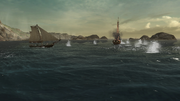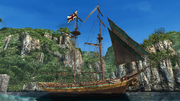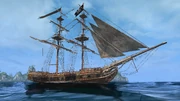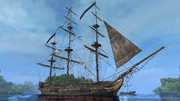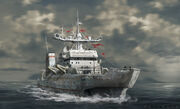Tags: Visual edit apiedit |
Tags: Visual edit apiedit |
||
| Line 34: | Line 34: | ||
*'''[[Schooner]]s''' had two sailing masts and were the "sloop-of-war" of their generation: small coastal patrol craft and fast attack craft armed with 18 or fewer medium-cannons. They were the preferred ships for privateers during the [[American Revolutionary War|American Revolution]].<ref name="AC3D" /> Their speed made them fantastic recon vessels, screening force, and minelayers. They dump gunpowder kegs in the sea, causing them to explode on impact with pursuing enemies (similar to laying [[naval mines]]).<ref name="Shipclass" /> They used grape-shot ammunition for fighting enemy ships. Rarely, these ships were used as fireships. |
*'''[[Schooner]]s''' had two sailing masts and were the "sloop-of-war" of their generation: small coastal patrol craft and fast attack craft armed with 18 or fewer medium-cannons. They were the preferred ships for privateers during the [[American Revolutionary War|American Revolution]].<ref name="AC3D" /> Their speed made them fantastic recon vessels, screening force, and minelayers. They dump gunpowder kegs in the sea, causing them to explode on impact with pursuing enemies (similar to laying [[naval mines]]).<ref name="Shipclass" /> They used grape-shot ammunition for fighting enemy ships. Rarely, these ships were used as fireships. |
||
| − | *'''[[Brig]]s''' |
+ | *'''[[Brig]]s''' are vessels with two square rigged masts (fore and main). The main mast of a brig is the aft one. To improve maneuverability, the main mast carries a small (gaff rigged) fore-and-aft sail. Brigs were the "corvette" of their generation. Brigs are fast and maneuverable and were used as both naval warships and merchant vessels. Brigs are equipped with a bow ram and 20-30 heavy cannons, allowing them to flank and heavily damage slower targets in battle. <ref name="Shipclass" /> |
==Modern times== |
==Modern times== |
||
Revision as of 08:10, 29 May 2017
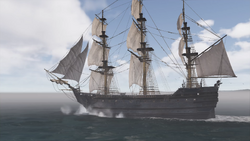
The Providence crossing the Atlantic Ocean
Ships are large seafaring vessels used to transport goods and passengers. During the Medieval Ages, ships were often used as outposts for merchants, guards or thieves, and fleets could form a blockade.
The introduction of cannons on ships turned them into weapons and guards for the colonial powers in America, while enabling the Assassins and pirates to become naval powers in their own right.
Medieval ships
During Medieval and Renaissance times, ships were divided into the smaller two-masted traghetti and larger, triple-masted carracks. The former were normally used as ferries, while the latter could serve as warships.[1][2] Most Italian ferries were painted blue,[3] although the ones in Rome appeared brown.[4] Italian and Ottoman carracks were identical in shape, but Ottoman ferries came in two variants, and could be rowed if necessary.[5]
Building ships required elm, oak and fir wood, while sails were made of flax.[2] Dockworkers at the Arsenale di Venezia were capable of building a ship every day at the height of Venice's power.[1] Ships were typically defended by archers,[6][4] although the Byzantine and Ottoman Empires utilized Greek Fire. The mercenaries in Constantinople outfitted their ferry with six cannons. Ships were susceptible to sticky bombs, which would detonate after being thrown onto the hull.[5]
Colonial ships
Cannons meant naval engagements were common in the Atlantic Ocean and Caribbean Sea by the 18th century. Ships would line up against each other and fire cannons, swivel guns or mortars, or ram each other. Chain shot could be fired to demast a ship if the captain decided to board instead of sink them. The Colonial Assassins formed their own navy by the 18th century.
Customized ships like the Jackdaw, the Morrigan, and the Aquila appeared to be experimental hybrids in an attempt to merge the best attributes of a brig and frigate. These vessels possessed firepower rivaling the best Man-of-War's of the era, giving them the advantage in strength, endurance and speed.[7] In 1754, Haytham Kenway sailed to Boston on the Providence, an English merchant ship that resembled a Man-of-War, due to her number of sails and gun decks. Merchant vessels in American cities typically had one gun deck.[8]
Ships needed to be crafted with spruce lumber, oak bark and bear grease, while sails could be sown with Linsey-woolsey[9], or with the simple cloth often carried in many ships' holds. Ships could be damaged by extreme weather, which usually spawned rogue waves and waterspouts, but this could be avoided or lessened by having the crew brace during a storm. Harbormasters could be paid to outfit a ship's hull with more wood or iron to make it more durable,[8] or to repair the ship if damage had been taken.[10]
On occasion, certain ships were also used as 'fireships', which could be converted into massive explosives with the proper application of pine pitch and gunpowder. When directed at an enemy ship, a fireship could often destroy the other vessel with its sheer destructive power. One such ship was Jack Rackham's schooner, which was used by Edward Kenway and Charles Vane to blast a hole in the naval blockade outside of Nassau.[10]
Rating system
Between 17th century and 19th century, the rating system of the British Royal Navy, categories sailing warships, according to their assigned complement of men and the number of their carriage-mounted guns. Ship types of this era included:
- 1st-4th rate
- Man O' War (Galleon) was a catch-all term for the largest and most powerful warships. Many of them were Ships of the Line, designed with multiple gun decks that could have up to 124 cannons of every caliber; four at the bow, eight at the stern and 54 on each broadside. They were also armed with both round-shot and heat-shot ammunition. Men-of-War and frigates had three sailing masts, and decommissioned warships like the HMS Jersey were eventually turned into prison ships.[11][12]
- 5th-6th rate
- Frigates were long, relatively light warships loaded with 24 to 46 heavy cannons. Due to their size and speed, they were often used for reconnaissance, escorting merchant ships, or as slave ships.[11][7] In combat, they could best any ship smaller than them and were the backbone of any fleet, often escorting Men O' War and leading Brigs and smaller ships in naval engagements.
- Unrated escorts
- Gunboats were small, inexpensive and easy to assemble ships. Armed only with one or two large heavy cannons (relative to its size) they were quite slow and weak. Most could be destroyed with only one accurate shot from a swivel gun or a direct ramming attack. They would usually be grouped together to maximize firepower in numbers.[11][7] Gunboats could also be used as fireships, as seen during the Siege of Louisbourg.
- Schooners had two sailing masts and were the "sloop-of-war" of their generation: small coastal patrol craft and fast attack craft armed with 18 or fewer medium-cannons. They were the preferred ships for privateers during the American Revolution.[11] Their speed made them fantastic recon vessels, screening force, and minelayers. They dump gunpowder kegs in the sea, causing them to explode on impact with pursuing enemies (similar to laying naval mines).[7] They used grape-shot ammunition for fighting enemy ships. Rarely, these ships were used as fireships.
- Brigs are vessels with two square rigged masts (fore and main). The main mast of a brig is the aft one. To improve maneuverability, the main mast carries a small (gaff rigged) fore-and-aft sail. Brigs were the "corvette" of their generation. Brigs are fast and maneuverable and were used as both naval warships and merchant vessels. Brigs are equipped with a bow ram and 20-30 heavy cannons, allowing them to flank and heavily damage slower targets in battle. [7]
Modern times
The modern Assassins operate a surveillance ship, the Altaïr II, which is captained by Gavin Banks.[13]
Gallery
References
- ↑ 1.0 1.1 Assassin's Creed II - Database
- ↑ 2.0 2.1 Assassin's Creed: Project Legacy - Crafting
- ↑ Assassin's Creed II
- ↑ 4.0 4.1 Assassin's Creed: Brotherhood
- ↑ 5.0 5.1 Assassin's Creed: Revelations
- ↑ Assassin's Creed
- ↑ 7.0 7.1 7.2 7.3 7.4 Assassin's Creed IV: Black Flag Ship Classes promotional image
- ↑ 8.0 8.1 Assassin's Creed III
- ↑ Assassin's Creed III - Crafting
- ↑ 10.0 10.1 Assassin's Creed IV: Black Flag
- ↑ 11.0 11.1 11.2 11.3 Assassin's Creed III - Database
- ↑ Assassin's Creed: Syndicate - Jack the Ripper (DLC)
- ↑ Assassin's Creed: Initiates




